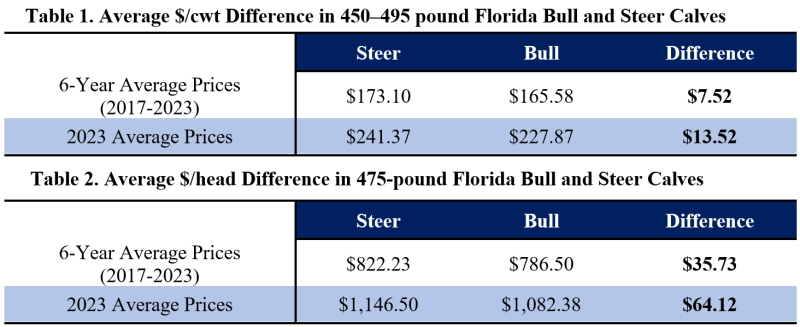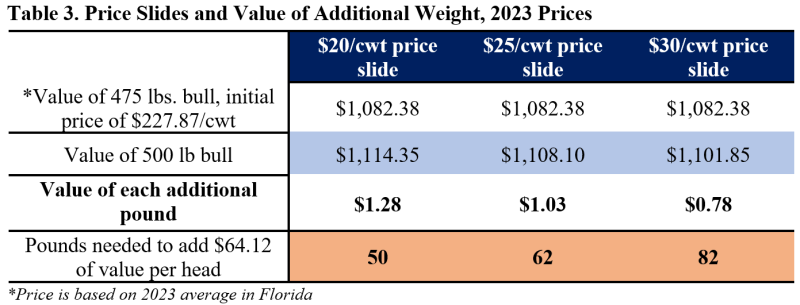Year after year, cattle producers have a calf crop with 50 percent bull calves. Many producers will castrate these bull calves, making them steers, for a multitude of reasons. Two reasons being that steer calves have a higher meat quality and are more docile than bull calves, making them easier to handle, which creates a safer work environment. However, the main reason for castrating bull calves, and why it is encouraged, is the higher price received for steer calves compared to bull calves. The prices and estimates in this article have been adapted from an article published by the University of Kentucky to specifically represent Florida prices in today’s market.
Florida ranks number nine in beef cow production (number of beef cattle) as of January 2024. With that being said, 84 percent of operations in the state are small operations with 1-50 head in a herd. Not castrating bull calves on small farms could be the result of several circumstances such as lack of proper facilities and labor. However, the price for steer calves compared to bull calves shows to be historically greater in Florida. Therefore, if possible, producers should consider implementing castration of bull calves as a management strategy to avoid receiving a discounted price.
According to the USDA-AMS Florida Weekly Livestock Auction Summary reports, prices for 450–495-pound steer calves in Florida over the last six years (October 2017-December 2023) have averaged five percent higher than average bull calf prices. In 2023, prices for steer calves were six percent higher on average. The discount in 2023 almost doubled the six-year average at $13.52/cwt or $64.12/head. It is evident that steer calves, on average, consistently receive a higher price than bull calves (Table 1 and Table 2).
However, bull calves may weigh slightly more than steer calves at the time of weaning, essentially bringing more total dollars. But after considering the price slide for entering a heavier weight class, what is the actual value of those extra pounds and how many additional pounds would that bull calf need to make up for the discount? The price slide is the amount that prices decrease as weight increases. For example, in 2023, a bull calf that weighs 475 pounds sells for $227.87/cwt or $1,082.38. With a $25/cwt price slide, much like we are seeing in today’s market, ($25 decrease for every 100-pound increase), a bull calf weighing 25 pounds more at 500 pounds sells for $1,108.10 ($227.87-$6.25) *5). The value of those additional 25 pounds comes out to $1.03/pound (Table 3). To make up for the $64.12 discount we saw in 2023, this bull calf would need to weigh 62 pounds more than the 475-pound steer calf. The 500-pound bull calf sells for $25 more than the 475-pound bull calf but is still short $39 to make up for the $64 discount compared to the 475-pound steer calf.
Price slides tend to increase when prices increase. This means that the value of each additional pound on a bull calf will decrease, and the pounds needed to close the price gap will increase. The key takeaway is that at face value, total dollars may increase when selling heavier bull calves, but the value of each additional pound decreases. This results in a discount in total dollars compared to the total dollars received for steer calves.
In conclusion, castration is encouraged on cow-calf operations in Florida, as well as across the country, to take advantage of higher prices. Along with castration, implanting steers is also a beneficial and economical option to achieve the weight gain of a bull calf without receiving the bull discount. Bull calf castration and growth implants are a sound and economical management practices that add more value to the male calves from the herd.
–
Burdine, K. “The Steer-Bull Price Differential: A Historical Perspective.” Economic and Policy Update (21):8, Department of Agricultural Economics, University of Kentucky, August 31st, 2021.
USDA, AMS. 2023. “Florida Weekly Livestock Auction Summary.” USDA, Economics, Statistics, and Market Information System.
USDA, NASS. 2017. “Table 16: Beef Cow Herd Size by Inventory and Sales: 2022.” USDA, NASS 2022 Census of Agriculture.
USDA, NAHMS. 2020. “Beef 2017 Report Part 1: Beef Cow-Calf Management Practices in the United States, 2017.” USDA, Animal and Plant Inspection Service.
- The Economic Influence of Intentional Management of Your Cow Herd - December 19, 2025
- December 2025 Florida Cattle Market Update - December 19, 2025
- October 2025 Florida Cattle Market Update - November 7, 2025


